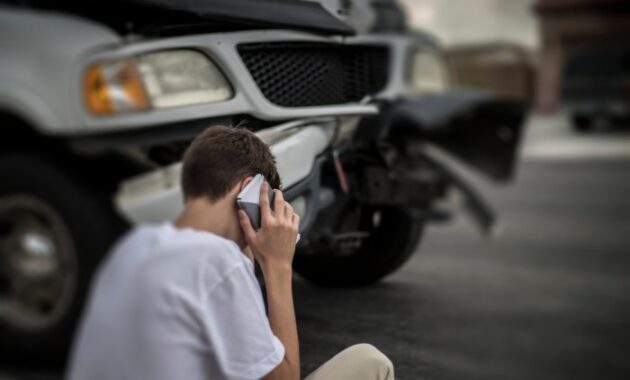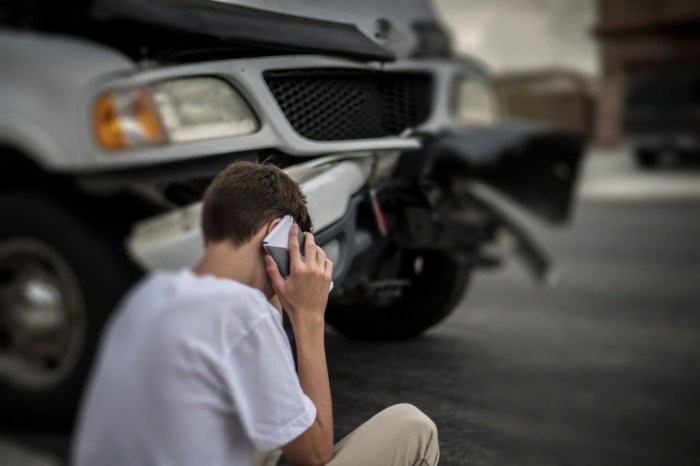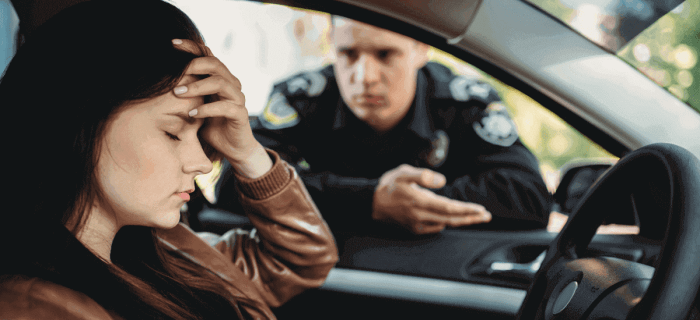
Driving without insurance is a gamble with potentially devastating consequences. Beyond the immediate legal repercussions, the financial and personal ramifications can be far-reaching and profoundly impact your life. This guide explores the multifaceted implications of driving uninsured, examining the legal penalties, financial burdens, and impact on others involved in accidents, ultimately aiming to highlight the importance of securing adequate auto insurance.
From hefty fines and license suspensions to crippling debt and protracted legal battles, the risks far outweigh any perceived benefits of forgoing insurance. Understanding these risks is crucial for responsible driving and ensuring both your personal safety and the safety of others on the road.
Legal Ramifications of Driving Without Insurance
Driving without insurance is a serious offense with significant legal consequences that vary by state. These consequences extend beyond simple fines and can impact your driving privileges, financial stability, and even your ability to obtain insurance in the future. Understanding these ramifications is crucial for responsible driving.
Consequences of Uninsured Driving by State
The penalties for driving without insurance differ considerably across the United States. Some states impose relatively modest fines, while others levy substantial penalties and lengthy license suspensions. These variations reflect differing state legislative priorities and approaches to enforcing insurance requirements. Factors like the driver’s history and the circumstances surrounding the offense also play a role in determining the severity of the penalties. For instance, a first-time offense in a state with stricter laws might result in more severe penalties than a repeat offense in a state with more lenient laws. It’s crucial to check your specific state’s laws for accurate and up-to-date information.
Fines and Penalties for Uninsured Driving
Fines for driving without insurance can range from a few hundred dollars to several thousand, depending on the state and the number of offenses. In addition to fines, many states impose additional penalties such as points added to the driver’s license, mandatory completion of driver improvement courses, and increased insurance premiums even after insurance is obtained. These additional penalties can significantly impact a driver’s financial situation and driving record. For instance, accumulating points on your license can lead to license suspension or revocation, further limiting driving privileges.
Legal Repercussions for First-Time vs. Repeat Offenders
First-time offenders typically face less severe penalties than repeat offenders. A first offense might result in a relatively small fine and a short suspension, while repeat offenses could lead to substantially higher fines, longer license suspensions, or even license revocation. The severity of the penalties also depends on the circumstances of the offense. For example, if uninsured driving is involved in an accident causing injury or property damage, the penalties are generally far more severe regardless of prior offenses.
License Suspension or Revocation for Uninsured Driving
Many states automatically suspend or revoke the driver’s license of individuals caught driving without insurance. The duration of the suspension varies by state and the number of offenses. In some states, the license is reinstated only after the driver pays all fines, obtains insurance, and possibly completes other requirements, such as attending a driver’s education course. Revocation is a more serious penalty, meaning the driver’s license is permanently taken away, and regaining driving privileges requires a more extensive process. The process of reinstatement can be lengthy and complex, adding to the overall burden on the driver.
Comparison of Penalties in Three Different States
| State | Fine | License Suspension | Other Penalties |
|---|---|---|---|
| California | $100 – $1000 (plus additional fees) | Up to 6 months (potentially longer for repeat offenses) | Points added to driving record, increased insurance premiums |
| Texas | $175 – $350 (plus court costs) | Up to 180 days (varies by county) | Possible vehicle impoundment, mandatory SR-22 insurance |
| New York | $500 – $1500 (plus surcharges) | Up to 1 year (potentially longer for repeat offenses) | Points added to driving record, increased insurance premiums, potential for civil penalties |
Financial Consequences of Driving Without Insurance
Driving without insurance exposes you to potentially devastating financial consequences, far exceeding the cost of a simple premium. A single accident can lead to crippling debt, impacting your credit score and overall financial well-being for years to come. Understanding these potential costs is crucial for responsible driving.
Costs of an Accident Without Insurance Coverage
The financial burden of an accident without insurance is immense. You become personally liable for all damages, including property damage to other vehicles and injuries sustained by others involved. These costs can quickly escalate into hundreds of thousands of dollars, depending on the severity of the accident. This includes medical bills for injured parties, vehicle repair or replacement costs, lost wages, and potential legal fees. Without insurance coverage, you are solely responsible for covering these expenses.
Examples of Significant Financial Burdens
Consider a scenario where an uninsured driver causes a multi-vehicle accident resulting in serious injuries. Medical bills alone for multiple individuals could easily exceed $100,000. Add to this the cost of repairing or replacing damaged vehicles, potentially totaling tens of thousands more. Legal fees for defending yourself against lawsuits could easily add another substantial sum. In this situation, the uninsured driver faces a potential debt well into the hundreds of thousands of dollars. Another example involves a less severe accident resulting in only property damage, but still involving multiple vehicles. Even minor accidents can accumulate significant repair costs that an uninsured driver must absorb entirely.
Impact on Credit Scores Due to Unpaid Judgments
If you are sued and lose a judgment in a court case stemming from an accident, the unpaid judgment will be reported to credit bureaus. This significantly damages your credit score, making it difficult to obtain loans, rent an apartment, or even secure a job in some cases. The negative impact on your credit score can persist for seven years or more, severely hindering your financial future. This long-term effect can be even more damaging than the immediate financial strain of paying for the accident.
Ways Uninsured Drivers Accumulate Substantial Debt
Uninsured drivers can accumulate substantial debt through various channels. First, there are direct costs associated with repairing or replacing damaged property. Second, there are the substantial medical expenses incurred by injured parties. Third, legal fees for defending oneself against lawsuits, which can quickly escalate. Fourth, collection agencies aggressively pursuing unpaid judgments can further exacerbate the situation, adding fees and interest to the original debt. Finally, the long-term impact on credit scores can lead to higher interest rates on future loans, further compounding the financial burden.
Potential Financial Consequences of Driving Without Insurance
- Massive medical bills for injured parties.
- High costs of vehicle repair or replacement.
- Significant legal fees for defending against lawsuits.
- Severe damage to credit score due to unpaid judgments.
- Aggressive debt collection actions leading to additional fees and interest.
- Difficulty obtaining loans, renting, or securing employment due to poor credit.
- Potential wage garnishment to satisfy judgments.
- Bankruptcy in extreme cases.
Impact on Others Involved in an Accident
Driving without insurance significantly impacts others involved in accidents, creating substantial challenges for those injured and highlighting the importance of adequate coverage. The consequences extend beyond the uninsured driver’s personal liability.
The potential liabilities faced by uninsured drivers in accidents involving injuries are severe. If an uninsured driver causes an accident resulting in injuries to another person, they become personally liable for all medical expenses, lost wages, pain and suffering, and property damage incurred by the injured party. This liability can quickly amount to hundreds of thousands, or even millions, of dollars, potentially leading to bankruptcy or wage garnishment. The injured party’s ability to recover these damages is directly dependent on the uninsured driver’s ability to pay, which is often severely limited.
Challenges Faced by Injured Parties in Recovering Damages
Injured parties face significant difficulties recovering damages from uninsured drivers. The primary challenge is the financial instability of the uninsured driver. Legal action may be necessary to pursue compensation, but even with a successful lawsuit, obtaining payment can prove incredibly difficult. The uninsured driver might lack the assets to satisfy a judgment, leaving the injured party with a significant financial burden and little recourse. This situation can exacerbate the emotional and physical trauma caused by the accident, placing an additional strain on the injured individual and their family. Collection agencies may be employed, but their success is far from guaranteed.
Uninsured/Underinsured Motorist Coverage Protects Other Drivers
Uninsured/underinsured motorist (UM/UIM) coverage is a crucial component of an individual’s insurance policy designed to mitigate the risks associated with accidents involving uninsured or underinsured drivers. This coverage protects the policyholder and their passengers by providing compensation for injuries and damages caused by an uninsured or underinsured driver, regardless of fault. The UM/UIM coverage will step in to cover medical expenses, lost wages, and other damages up to the policy limits, providing a crucial safety net when dealing with an uninsured driver. For example, if a driver with $100,000 in UM/UIM coverage is injured by an uninsured driver, their insurance company will pay up to $100,000 in damages, regardless of the uninsured driver’s lack of insurance.
Legal Processes for Resolving Accidents With and Without Insurance
The legal processes for resolving accidents differ significantly depending on whether the at-fault driver is insured. Accidents involving insured drivers typically involve a relatively straightforward process. Insurance companies handle the claims, negotiating settlements, and providing compensation to the injured party. The process can still be lengthy and complex, but the presence of insurance significantly simplifies the financial aspects. In contrast, accidents involving uninsured drivers necessitate lengthy legal proceedings. Injured parties must file lawsuits, which can take years to resolve, incurring substantial legal fees in the process. Even after winning a judgment, collecting the damages can prove extremely challenging, potentially requiring extensive legal action to seize the uninsured driver’s assets. The financial and emotional toll on the injured party is dramatically higher in cases involving uninsured drivers. Consider a hypothetical scenario where an uninsured driver causes a serious accident, resulting in significant medical bills and lost wages for the injured party. With insurance, the injured party would likely receive a prompt settlement covering their losses. Without insurance, the injured party faces years of legal battles and significant uncertainty regarding compensation.
The presence or absence of insurance dramatically alters the landscape of accident resolution, significantly impacting the injured party’s ability to recover damages and receive timely compensation.
Insurance Options and Obtaining Coverage

Securing the right auto insurance is crucial for responsible driving. Understanding the different policy types, influencing factors on premiums, and available resources can help you find affordable and suitable coverage. This section will guide you through the process of obtaining car insurance, from choosing a policy to comparing quotes.
Types of Auto Insurance Policies
Several types of auto insurance policies cater to different needs and budgets. Liability coverage is the most basic, protecting you financially if you cause an accident resulting in injuries or property damage to others. Collision coverage protects your vehicle in accidents regardless of fault. Comprehensive coverage extends protection to damage from events like theft, vandalism, or natural disasters. Uninsured/underinsured motorist coverage safeguards you if you’re involved in an accident with a driver who lacks or has insufficient insurance. Personal injury protection (PIP) covers medical expenses and lost wages for you and your passengers, regardless of fault.
Factors Influencing Insurance Premiums
Numerous factors determine your auto insurance premiums. Your driving record (accidents, violations), age, location (higher crime rates mean higher premiums), type of vehicle (sports cars generally cost more to insure), credit history (in many states), and the amount of coverage you choose all play a significant role. For example, a driver with multiple speeding tickets will likely pay more than a driver with a clean record. Similarly, insuring a high-performance vehicle will generally be more expensive than insuring a compact car.
Resources for Affordable Insurance
Finding affordable insurance can be challenging, but several resources are available. State-sponsored programs often offer assistance to low-income drivers. Independent insurance agents can compare quotes from multiple insurers, saving you time and effort. Online comparison tools allow you to input your information and receive quotes from various companies simultaneously. Consider increasing your deductible to lower your premiums, but remember this means you’ll pay more out-of-pocket in case of an accident.
Comparing Insurance Quotes
Comparing quotes is vital for securing the best coverage at the most competitive price. Use online comparison websites to obtain multiple quotes simultaneously. Pay close attention to the coverage details of each quote; don’t just focus on the price. Ensure the coverage limits meet your needs and consider the insurer’s reputation and customer service ratings. Contact insurers directly to clarify any uncertainties or request additional information. Remember that the cheapest option isn’t always the best if it lacks essential coverage.
Obtaining Car Insurance: A Step-by-Step Guide
- Gather necessary information: This includes your driver’s license, vehicle identification number (VIN), and details about your driving history.
- Obtain quotes from multiple insurers: Utilize online comparison tools or contact insurers directly.
- Compare quotes carefully: Consider coverage, price, and the insurer’s reputation.
- Choose a policy: Select the policy that best meets your needs and budget.
- Provide payment information: Pay the initial premium to activate your policy.
- Receive proof of insurance: Keep this document readily available in your vehicle.
Illustrative Scenarios of Uninsured Driving

Understanding the consequences of driving without insurance is best illustrated through real-world examples. These scenarios highlight the potential ramifications, both legally and financially, for the uninsured driver and those involved.
Minor Accident: Fender Bender
Imagine two cars lightly colliding at a low speed in a parking lot. One driver, Sarah, is uninsured. The other driver, Mark, has full coverage. Sarah’s car sustains a small dent in the bumper, while Mark’s car has a minor scratch on the fender. The police are called, and a report is filed. While the damage is relatively minor, Sarah faces significant financial repercussions. She will likely be responsible for the full cost of repairing Mark’s vehicle, and she may also face fines and license suspension. The emotional toll is also significant for both drivers, with Mark potentially experiencing frustration and inconvenience from dealing with the repair process, and Sarah burdened by the unexpected and substantial financial burden. The overall scene depicts a relatively minor collision, yet the aftermath is anything but minor for the uninsured driver.
Serious Accident with Injuries
Consider a more serious scenario. John, an uninsured driver, runs a red light and collides with a vehicle carrying a family of four. The impact is severe, resulting in broken bones and serious injuries to the family members. John’s car is totaled, and the family’s vehicle is extensively damaged. The injured family members require extensive medical treatment, resulting in substantial medical bills. John, due to his lack of insurance, is personally liable for all medical expenses, vehicle repairs, and potential lawsuits. The physical aftermath is stark: mangled vehicles, broken glass, and the scene of an emergency response. Emotionally, the scene is charged with fear, pain, and uncertainty for the injured family. John faces not only financial ruin but also the weight of causing severe harm to others, with potential criminal charges added to the civil liabilities.
Hit-and-Run Incident
In a hit-and-run scenario, Maria, driving without insurance, sideswipes a parked car causing significant damage to the vehicle’s side panel and door. Instead of stopping, she flees the scene. The physical damage is obvious: a deeply scratched and dented car, potentially with broken glass scattered around. The emotional consequences are significant for the owner of the parked car, who discovers the damage and faces the inconvenience and expense of repairs, alongside the frustration and anger of the hit-and-run. Maria, however, faces far graver consequences. Besides the significant financial burden of the damage, she faces potential criminal charges for leaving the scene of an accident and driving without insurance, leading to severe penalties, including imprisonment. The aftermath is a scene of damage and abandonment, leaving a trail of legal and emotional turmoil for all involved.
Closure

Driving without insurance is a risky proposition with significant consequences that extend far beyond a simple traffic violation. The potential for substantial financial losses, legal battles, and lasting damage to your personal life underscores the critical importance of securing appropriate auto insurance coverage. Protecting yourself and others on the road is paramount, and obtaining insurance is a responsible step towards achieving this.
FAQ Guide
What if I only drive without insurance occasionally?
Even occasional uninsured driving carries significant risk. A single incident can lead to severe penalties, regardless of how often you drive without insurance.
Can I get insurance after being caught driving without it?
Yes, but obtaining insurance after an uninsured driving conviction may be more challenging and expensive due to higher premiums. Your driving record will reflect the violation.
How long does a license suspension for uninsured driving last?
The duration of a license suspension varies by state and the severity of the offense. It can range from a few months to several years.
What if I’m involved in an accident and the other driver is uninsured?
Having uninsured/underinsured motorist coverage on your own policy will help protect you in such a situation. Without it, recovering damages can be difficult and costly.